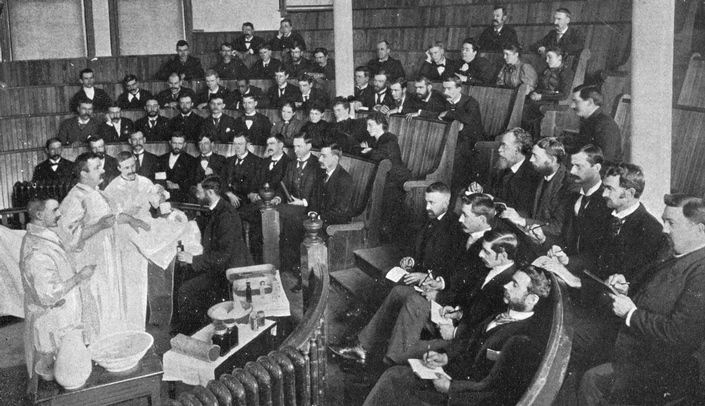In 1895, Mary Louise Tinley, MD, (1869-1953) graduated with three other women from the Omaha Medical College, which was the precursor to UNMC.
At a time when women did not have the right to vote, Dr. Tinley opened a medical practice, advocated for women’s health, served as a railroad surgeon and held leadership positions in the medical community.
Arriving for school from neighboring Council Bluffs, Dr. Tinley was among the first group of students who spent their three years of school in the newly built medical college located at 12th and Pacific streets in Omaha. The senior year consisted of weekly lectures on 13 subjects and three weekly clinics. There were five end-of-year exams broadly covering those subjects.
A standout student, Dr. Tinley was recognized for receiving the highest total marks in the 1894 examinations. The award was a general surgery case. In her senior year, she served as the class vice-president. Dr. Tinley remained active in the alumni association, giving the alumni toast at the class of 1899 graduation exercises and serving as the association treasurer for many years.
After her education at the Omaha Medical College, Dr. Tinley attended the New York Post-Graduate Medical School and Hospital, followed by the New York Polyclinic Hospital, where she studied operative gynecology. She returned to the midwest and opened a medical practice in Council Bluffs. She later was joined in practice by her brother, Mathew Tinley, MD, a 1902 graduate of the Omaha Medical College and a war veteran. Dr. Tinley made house calls to her patients in an open horse-drawn carriage called a phaeton. Later, she became an early adopter of the automobile. In addition to medical care, she would bring her patients food if they were too sick to cook, as was the case during the 1918 influenza pandemic.
Dr. Tinley researched and wrote about obstetrics and gynecology. After 1919, hospital physicians and surgeons were adopting minimum standards of practice. Dr. Tinley advocated adding obstetrics to the standardization to reduce infant and mother morbidity and mortality rates. In her 1922 article, "The Relation of Hospital Standardization to Obstetrics," she recommended that nurses be trained in hospitals and then return to the rural community with "the same accurate methods of diagnosis and skilled prophylaxis and treatment as used in the hospitals from which they came."
Having studied railroad surgery at the Omaha Medical College, Dr. Tinley served as a district surgeon for Union Pacific Railroad’s line from Council Bluffs to Omaha. She also held several professional memberships and served on the medical board of the Jennie Edmundson Memorial Hospital in Council Bluffs.
In 1952, Dr. Tinley was honored as "Woman of the Year" by the Council Bluffs Chamber of Commerce. She continued to see patients until her death on June 24, 1953.

What a remarkable woman! Thank you for sharing her story.
What a wonderful and inspiring story! Thank you, Dr. Tinley for paving the way for women in medicine and for the research and education of women health.
So proud of the accomplishments of my Great Aunt!
What a pioneer!